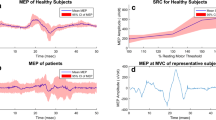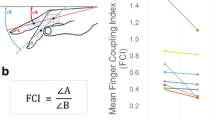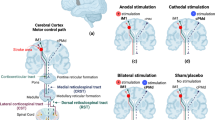Abstract
The standardization of patient evaluation and monitoring methods has a special importance in evaluating the effectiveness of therapeutic methods using drugs or rehabilitative techniques in stroke rehabilitation. The aim of this study was to investigate the relationships between clinical instruments and transcranial magnetic stimulation (TMS)-evoked neurophysiological parameters in stroke patients. This study included 22 chronic post-stroke patients who were clinically assessed using the Motricity Index (MI), finger-tapping test (FTT), Motor Activity Log (MAL) 28, Brunnstrom motor staging and Ashworth Scale (ASH). Motor-evoked potential (MEP) latency and amplitude, resting motor threshold (rMT) and central motor conduction time (CMCT) were measured with TMS. Shorter MEP-latency, shorter CMCT, higher motor-evoked potential amplitude, and diminished rMT exhibited significant correlations with clinical measures evaluating motor stage, dexterity, and daily life functionality. rMT exhibited a negative correlation with hand and lower extremity Brunnstrom stages (r = −0.64, r = −0.51, respectively), MI score (r = −0.48), FTT score (r = −0.69), and also with amount of use scale and quality of movement scale of MAL 28 scores (r = −0.61, r = −0.62, respectively). Higher MEP amplitude and diminished rMT showed positive correlations with reduced ASH score (r = −0.65, r = 0.44, respectively). The TMS-evoked neurophysiologic parameters including MEP latency, amplitude, rMT and CMCT generally have positive correlation with clinical measures which evaluate motor stage, dexterity and daily life functionality. Additionally, spasticity has also remarkable relationships with MEP amplitude and rMT. These results suggest that TMS-evoked neurophysiological parameters were useful measures for monitoring post-stroke patients.
Similar content being viewed by others
References
Aksakalli E, Turan Y, Sendur OF (2009) Outcome scales in stroke rehabilitation. Turk J Phys Med Rehabil 55:168–172
Kobayashi M, Pascual-Leone A (2003) Transcranial magnetic stimulation in neurology. Lancet Neurol 2(3):145–156
Stinear CM, Barber PA, Smale PR, Coxon JP, Fleming MK, Byblow WD (2007) Functional potential in chronic stroke patients depends on corticospinal tract integrity. Brain 130(1):170–180
Brouwer BJ, Schryburt-Brown K (2006) Hand function and motor cortical output poststroke: are they related? Arch Phys Med Rehabil 87(5):627–634
Thickbroom GW, Byrnes ML, Archer SA, Mastaglia FL (2002) Motor outcome after subcortical stroke: MEPs correlate with hand strength but not dexterity. Clin Neurophysiol 113(12):2025–2029
Lissens MA (2010) Clinical applications of transcranial magnetic stimulation in rehabilitation medicine. In: Akyüz G, Tanrıdağ T, Türkdoğan D et al (eds) Practical guide on electrodiagnosis. Günes Tıp Kitabevleri, Ankara, pp 319–322
Thickbroom GW, Byrnes ML, Archer SA, Mastaglia FL (2004) Motor outcome after subcortical stroke correlates with the degree of cortical reorganization. Clin Neurophysiol 115(9):2144–2150
Bembenek JP, Kurczych K, Karli Nski M, Czlonkowska A (2012) The prognostic value of motor-evoked potentials in motor recovery and functional outcome after stroke—a systematic review of the literature. Funct Neurol 27(2):79–84
Amengual JL, Valero-Cabré A, de las Heras MV, Rojo N, Froudist-Walsh S, Ripolles P (2012) Prognostic value of cortically induced motor evoked activity by TMS in chronic stroke: caveats from a revealing single clinical case. BMC Neurol 12:35
Koski L, Mernar TJ, Dobkin BH (2004) Immediate and long-term changes in corticomotor output in response to rehabilitation: correlation with functional improvements in chronic stroke. Neurorehabil Neural Repair 18(4):230–249
Malhotra S, Cousins E, Ward A et al (2008) An investigation into the agreement between clinical, biomechanical and neurophysiological measures of spasticity. Clin Rehabil 22(12):1105–1115
Dromerick AW, Edwards DF, Diringer MN (2003) Sensitivity to changes in disability after stroke: a comparison of four scales useful in clinical trials. J Rehabil Res Dev 40(1):1–8
Cakar E, Sert G, Durmus O, Dincer U, Kiralp MZ (2009) Informed consent in current medicine: with concomitance of models for common procedures in physical medicine and rehabilitation. J PMR Sci 12:147–160
Lane AE (2007) Achieving functional independence. In: Braddom RL (ed) Physical medicine and rehabilitation. Elsevier Inc, Philadelphia, pp 581–596
Safaz I, Yilmaz B, Yaşar E, Alaca R (2009) Brunnstrom recovery stage and motricity index for the evaluation of upper extremity in stroke: analysis for correlation and responsiveness. Int J Rehabil Res 32(3):228–231
Tyson SF, Chillala J, Hanley M, Selley AB, Tallis RC (2006) Distribution of weakness in the upper and lower limbs post stroke. Disabil Rehabil 28(11):715–719
Loubinoux I, Dechaumont-Palacin S, Castel-Lacanal E et al (2007) Prognostic value of fMRI in recovery of hand function in subcortical stroke patients. Cereb Cortex 17(12):2980–2987
Cakar E, Dincer U, Kiralp MZ, Kilac H, Tongur N, Taub E (2010) Turkish adaptation of Motor Activity Log 28. Turk J Phys Med Rehab 56:1–5
Brandstater ME (1998) Stroke rehabilitation. In: DeLisa JA (ed) Rehabilitation Medicine principles and practice. Lippincott-Raven Publishers, Philadelphia, pp 1165–1189
Nance PW, Meythaler JM (2007) Spasticity Management. In: Braddom RL (ed) Physical medicine and rehabilitation. Elsevier Inc, Philadelphia, pp 651–667
Romeo P, Lavanga V, Pagani D, Sansone V (2014) Extracorporeal shock wave therapy in musculoskeletal disorders: a review. Med Princ Pract 23(1):7–13
Rossini PM, Barker AT, Berardelli A et al (1994) Non-invasive electrical and magnetic stimulation of the brain, spinal cord and roots: basic principles and procedures for routine clinical application. Report of an IFCN committee. Electroencephalogr Clin Neurophysiol 91(2):79–92
Nascimbeni A, Gaffuri A, Granella L, Colli M, Imazio P (2005) Prognostic value of motor evoked potentials in stroke motor outcome. Eur Medicophys 41(2):125–130
Pizzi A, Carrai R, Falsini C, Martini M, Verdesca S, Grippo A (2009) Prognostic value of motor evoked potentials in motor function recovery of upper limb after stroke. J Rehabil Med 41(8):654–660
Barker AT (2002) The history and basic principles of magnetic nerve stimulation. In: Pascual-Leone A, Davey NJ, Rothwell J et al (eds) Handbook of transcranial magnetic stimulation. Oxford University Press Inc, New York, pp 3–17
Balu S (2009) Differences in psychometric properties, cut-off scores, and outcomes between the Barthel Index and Modified Rankin Scale in pharmacotherapy-based stroke trials: systematic literature review. Curr Med Res Opin 25(6):1329–1341
Pisano F, Miscio G, Del Conte C, Pianca D, Candeloro E, Colombo R (2000) Quantitative measures of spasticity in post-stroke patients. Clin Neurophysiol 111(6):1015–1022
van Kuijk AA, Pasman JW, Geurts AC, Hendricks HT (2005) How salient is the silent period? The role of the silent period in the prognosis of upper extremity motor recovery after severe stroke. J Clin Neurophysiol 22(1):10–24
Bernard JA, Seidler RD (2012) Evidence for motor cortex dedifferentiation in older adults. Neurobiol Aging 33(9):1890–1899
Author information
Authors and Affiliations
Corresponding author
Ethics declarations
Conflict of interest
The authors declare that they have no conflict of interest.
Ethical approval
The study was approved by the local Ethics Committee and performed according to the tenets of the declaration of Helsinki.
Informed Consent
Informed consent was obtained from all individual participants.
Rights and permissions
About this article
Cite this article
Cakar, E., Akyuz, G., Durmus, O. et al. The relationships of motor-evoked potentials to hand dexterity, motor function, and spasticity in chronic stroke patients: a transcranial magnetic stimulation study. Acta Neurol Belg 116, 481–487 (2016). https://doi.org/10.1007/s13760-016-0633-2
Received:
Accepted:
Published:
Issue Date:
DOI: https://doi.org/10.1007/s13760-016-0633-2




